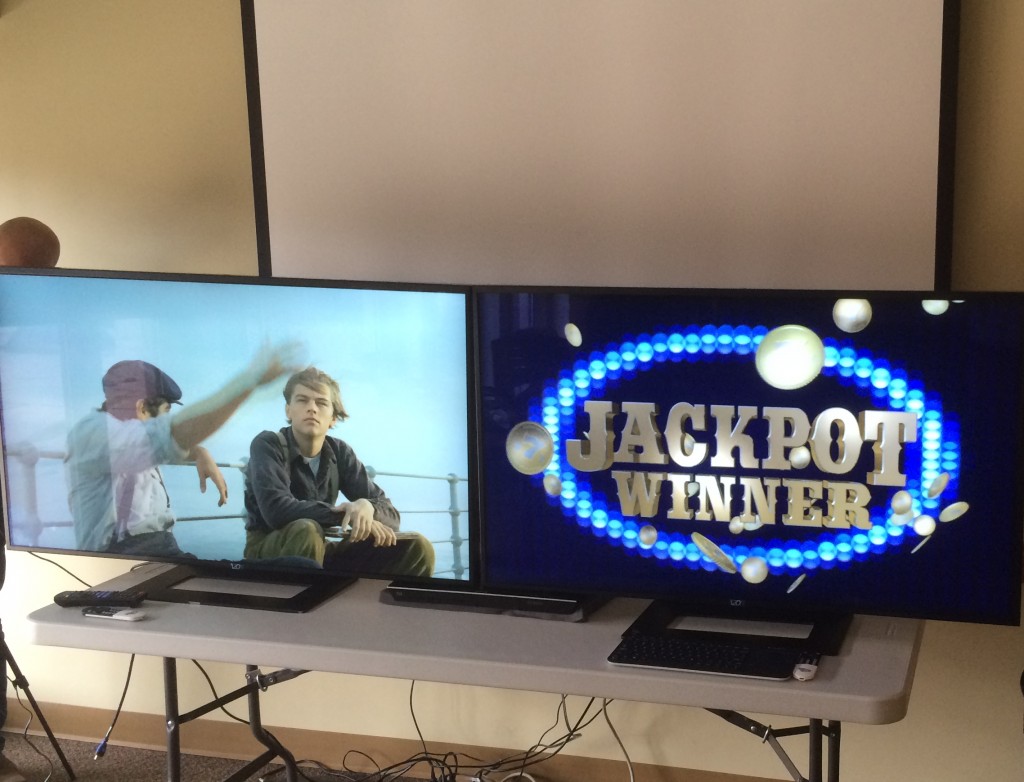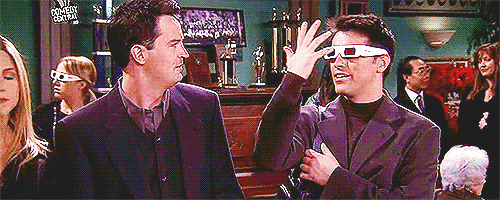A few months ago the DDMC at Duke took a look at a glasses free 3D display from IZON. They were extremely impressed by it. IZON was on their way to the NAB show in Vegas and they were nice enough to stop here on campus to demo their displays.
They brought 2 displays with them to demonstrate how it could be used either for digital signage or with more traditional content. We had quite a few people show up to look at the displays and the general consensus was that the tech was pretty impressive.

Background
IZON has been doing 3D conversions and content creation for the film industry for quite a few years. In fact they have created their own software to do 3D conversions. What they have done is take that software, and put it on a chip that can be installed in displays. They use a lenticular lens on the front of the display that can be tweaked with the chip to work most effectively at certain distances. (The default is 9 – 12 feet.) IZON buys the 4K panels from a large OEM and assembles the displays themselves in Florida.
As you move around the room, the intensity of the effect changes. (If you ‘re looking at the display while you’re moving, the effect can be a bit disorienting.) The viewing angles are very impressive. As you move from 90° from the display towards the side, the effect gradually diminishes until you get to about a 25° degree angle. Then it just stops. You’re not left with a blurry and unwatchable picture though. It’s now just a 2D image that still looks as good as most displays at that angle.

The process couldn’t be easier. Any 3D content (DVD, Blu-Ray, 3D-Camcorder, etc) that you feed into the display is processed in real time and the effect is impressive. If you give it normal 2D content, you just get 2D content as you would expect.

This is the holy grail of 3D acceptance really. Insert content, press play, enjoy. No glasses. No lighting restrictions. No limited seating positions. Just high quality 3D content.
A few observations about each application:
Digital Signage
- The content was extremely attention grabbing and some items appeared to come off the screen
- The quality of the effect is entirely dependant on the quality of the content.
- The displays currently only do 3D in landscape orientation
- Gave me a headache after looking at it for 2 hours
Consumer Content
- Titanic looked great for a movie that wasn’t filmed in 3D
- Wasn’t distracting or headache inducing
- I really wanted to see Avatar after this
Camcorder
- This was the least impressive but it’s consumer grade hardware doing real time processing. Better to err on the side of caution and restraint
- Very dependant upon the device and the environment (distance to objects, lighting, focal length)
We had one person from Architecture that really wanted to view some of their 3D renderings on the display. We tried on both a MacBook Pro and a Lenovo laptop to get this working but were unable to figure it out. Basically you have to get the computer to output content in side by side mode and we couldn’t figure that out on either system. Not all video cards and drivers are capable of doing this and laptops are probably the least likely to be able to do so. I’m sure a nice desktop video card could do this easily.
Implications
It wasn’t hard to think of a few ways that these displays could be used on campus.
- Viewing 3D renderings and walkthroughs of buildings and rooms
- 3D video production and editing
- Digital signage
- Video game design
- Creating and viewing models, samples and scans of scientific or artistic objects (pottery, bones, fossils, etc.)
- Displaying molecules
- New data visualization techniques
What’s next?
The two biggest things standing in the way of this technology aren’t new. Content and price.
Content: Where do you get 3D content? Sure you can get a lot of movies in 3D but once you expand beyond that, your options shrink. ESPN-3D is shut down for the time being. This would be amazing for digital signage but you’d have to have someone make the content for you. I’m sure there’s no shortage of places that do this, including IZON themselves, but how much will it cost you to have it produced? The inability to use it in portrait mode is also limiting. They’re working on this but they have a long list of other things to work on as well.
Price: The list price on a 50″ unit is over double what you would pay for 4K 3D TV that requires glasses. Later this year they will be shipping a 65″. Considering the capabilities of these units (3D and 4K capable) the prices aren’t horrendous. 10 years ago a 50″ plasma would have cost you about the same. I’m sure as production increases, competitors emerge, and licensing deals are struck, prices will drop quickly.
This isn’t for everyone. Certainly not in academia. But if you want to have a group discussion and display content in 3D, right now you really don’t have any good options. Unless you’re happy with everyone wearing glasses or an Oculus Rift. With one of these displays, it’s very doable. I can definitely see one of these in an architect or engineer’s office or conference room.
I have to say that the most drool worthy thing I saw was their pre-production 3D tablet. (They were carrying it in a Pelican hard shell case and bubble wrap.) It’s a 10″ Android unit and the effect was amazing. They played a movie clip with some of the head’s up display from Ironman and… WHOA!!! It is truly Tony Stark’s tablet. Jaw droppingly awesome.
Many thanks to IZON for making the trip and showing us what’s just beyond the horizon!
